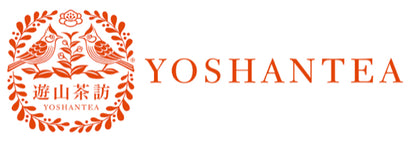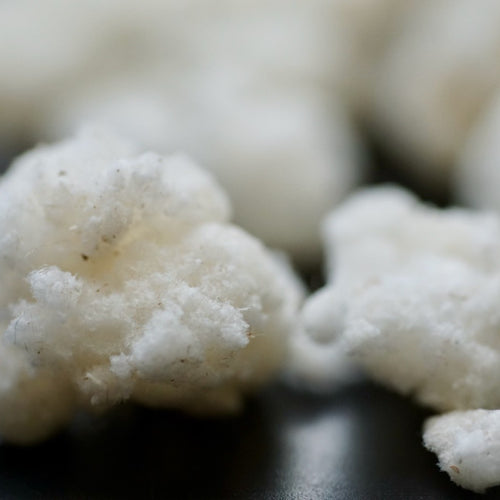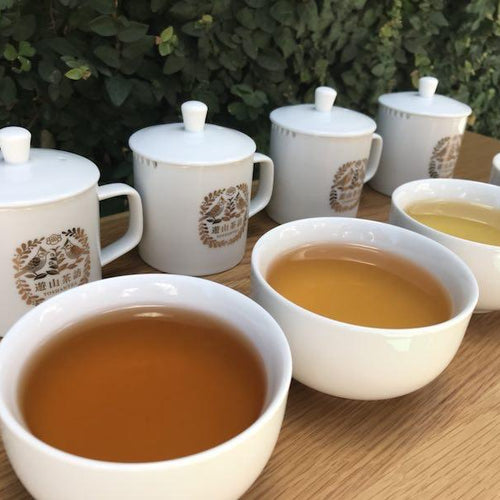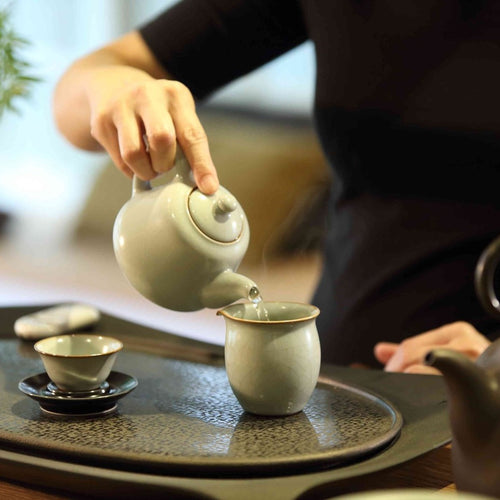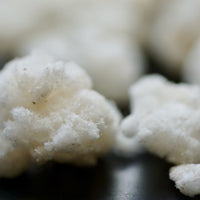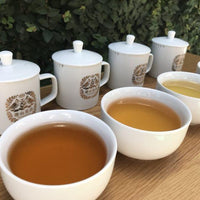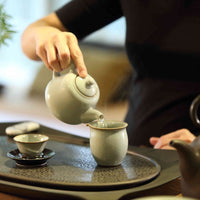簡單敘述茶葉有很多不同的分法,例如用地名、品種、季節來區分,再帶到茶葉主要的分類方式是以發酵程度來區分(不發酵、部分發酵、完全發酵、後發酵等)
臺灣茶命名方式相當多元且複雜,阿里山茶、高山茶、台茶18號、蜜香茶,諸多有關茶的名稱,總是令人混淆,只要掌握住原理,即相當容易辨別。
-為什麼有這麼多名字?
能使商品名稱更容易吸引消費者。
如清香梨山烏龍茶為原始名稱,可被命名為高冷茶、雲霧茶、雪山茶。
-命名的基本要素。
基本要素可包含,香氣、產地、品種、製作方法。
例如凍頂茶,其正確名稱為濃香凍頂青心烏龍烏龍茶。
命名方式有以下幾種元素構成:
產地:
木柵、文山、新竹(峨眉、北埔)、名間、竹山、凍頂、衫林溪、翠峰、梨山、阿里山、瑞穗、台東
製作方法(發酵程度不同):
綠茶(不發酵)、烏龍茶(部分發酵)、紅茶(完全發酵)、黑茶(後發酵)
精緻加工方法:
烘焙、窨花
品種:
青心烏龍、金萱茶、四季春、翠玉茶、鐵觀音、紅玉、阿薩姆
季節:
春茶、夏茶、秋茶、冬茶
臺灣茶主要命名方式為將產地+品種+製作方法合併在一起命名,季節多為備註名稱。
如:阿里山金萱烏龍茶 春茶
那阿里山茶(市面常見名稱)是什麼?
因為臺灣大多數人都喝青心烏龍品種所製成烏龍茶,所以會將香型、品種名、製作方法簡略。
正確名稱應為阿里山青心烏龍烏龍茶。
如果不是青心烏龍所製烏龍茶,則會特別將品種寫出來,如阿里山金萱茶(市面常見名稱),正確名稱為阿里山金萱烏龍茶。
隨著時間的演進,因為某些獨特製茶工藝只在特定區域發展,所以產地可代表其製作工藝。
烏龍茶是綠茶嗎?
烏龍茶不是綠茶,這是兩種不同的製茶方法。這茶名會讓大家混淆,主要原因為清香型烏龍茶喝起來相當清甜,加上製造技術不佳,會讓原本該發酵較足的烏龍茶喝起來滋味相當清淡,有如綠茶一般。真正的綠茶喝起來必須帶有青草香,有如割草過後空氣中的味道。
介紹台灣茶葉種類,用地區做分類,例如:文山包種茶、阿里山烏龍茶、凍頂烏龍茶等,也可用茶樹類型做分類,例如:青心烏龍、四季春、金萱等(舉出4~6種常見類型)
以地區進行分類:
文山包種茶:原意指種植在文山茶區並以青心烏龍所製直條型清香烏龍茶,後來衍生為清香型條索狀清香烏龍茶的代稱。
東方美人茶:原意指種在新竹峨眉、北捕茶區茶葉,並遭受小綠葉蟬叮咬後所製成帶有蜜香的烏龍茶,後來衍生為蜜香烏龍芽茶的代稱。
凍頂烏龍茶:原意指種植在凍頂山上,以青心烏龍為原料,經團揉與烘焙後所製成的濃香半球型烏龍茶,後來衍生為濃香半球型烏龍茶的代稱。
高山茶:原意指種植在海拔高度超過1000公尺以上的山區,經團揉後所製成的清香半球型烏龍茶,後來衍生為清香半球型烏龍茶的代稱。
以滋味進行分類:
清茶:指清香烏龍茶
生茶:指清香烏龍茶
甜香茶:指經過輕微烘焙的足發酵烏龍茶,回甘滋味持久
半熟茶:指經過輕微烘焙清香烏龍茶
熟茶:指經過烘焙且茶湯呈現深金黃至黃褐色烏龍茶
老人茶:指經過重烘焙且茶湯呈現黃褐色烏龍茶
以品種進行分類
金萱茶:以金萱品種所製成烏龍茶。
翠玉茶:以翠玉品種所製成烏龍茶。
四季春茶:以四季春品種所製成烏龍茶。
阿薩姆紅茶:以阿薩姆品種所製成紅茶。
紅玉紅茶:以紅玉品種所製成紅茶。
小葉種紅茶:以小葉種茶,如金萱、青心烏龍、四季春所製成紅茶。
以典故、產銷班或新創名字命名的茶葉商品名:
如:珠露茶、雪山茶、雲霧茶、上將茶、總統茶、冠軍茶....
介紹4種不同的發酵程度以及其相對應的茶葉分類和茶色(可以用表格呈現),並說明綠茶、烏龍茶、清茶和紅茶的關係
| 發酵程度 | 製作工藝名稱 | 臺灣茶代表 | 常見茶葉品種 | 沖泡水溫 | 茶湯顏色 | 精緻工藝名稱 |
|---|---|---|---|---|---|---|
| 不發酵 | 綠茶 | 碧螺春 | 青心柑仔 | 70~80度 | 綠 | 無 |
| 不發酵 | 綠茶 | 龍井 | 青心柑仔 | 70~80度 | 綠 | 無 |
| 部分發酵 | 烏龍茶 | 文山包種茶 | 青心烏龍 | 95度以上 | 金黃 | 無 |
| 部分發酵 | 烏龍茶 | 清香烏龍茶 | 四季春/翠玉/金萱 | 95度以上 | 金黃 | 無 |
| 部分發酵 | 烏龍茶 | 高山烏龍茶 | 青心烏龍/金萱 | 95度以上 | 金黃 | 無 |
| 部分發酵 | 烏龍茶 | 花茶 | 青心烏龍/金萱/四季春/翠玉 | 95度以上 | 金黃 | 窨花 |
| 部分發酵 | 烏龍茶 | 凍頂烏龍茶 | 青心烏龍 | 95度以上 | 深金黃 | 烘焙 |
| 部分發酵 | 烏龍茶 | 鐵觀音 | 鐵觀音 | 95度以上 | 深金黃 | 烘焙 |
| 部分發酵 | 烏龍茶 | 東方美人茶 | 青心大冇 | 80~85度 | 深金黃 | 無 |
| 部分發酵 | 烏龍茶 | 紅烏龍 | 青心烏龍/金萱 | 95度以上 | 橘紅 | 烘焙 |
| 全發酵 | 紅茶 | 小葉種紅茶 | 青心烏龍/金萱 | 90~95度 | 橘紅 | 無 |
| 全發酵 | 紅茶 | 蜜香紅茶 | 大葉烏龍 | 90~95度 | 橘紅 | 無 |
| 全發酵 | 紅茶 | 阿薩姆紅茶 | 阿薩姆 | 90~95度 | 紅 | 無 |
| 全發酵 | 紅茶 | 紅玉紅茶 | 紅玉 | 90~95度 | 紅 | 無 |
綠茶、烏龍茶、紅茶是指不同發酵程度的製茶方法。適切來說,是指氧化程度的不同。
發酵是指運用微生物,使有機物分解的生物化學反應過程。
茶葉氧化倚靠自身氧化酵素進行,有如香蕉從綠色變成深黃色的過程。
不同茶葉品種具有適合的製茶方法。如阿薩姆適合製作成紅茶,如製成烏龍茶或綠茶其風味不佳,難以入口。
凍頂烏龍茶必須使用發酵程度較高的茶葉,加上烘焙,才能產生獨特風味,其滋味強烈,回甘持久,而且能夠長期存放。
茶葉發酵與烘焙沒有關係。烘焙只會讓滋味加重,並不會加重發酵程度。如綠茶不會因為烘焙變成紅茶。
臺灣沒有黑茶,黑茶是指熟普洱茶、湖南黑茶、廣西六堡茶。
英文Black Tea 為紅茶,因為歐洲人是以茶葉外觀顏色命名,亞洲以茶湯顏色命名。
Oolong Tea is Not Green Tea!!
This article teaches you how to distinguish the different types of tea in Taiwan
Briefly describe that there are many different classification methods for tea, such as distinguishing by place name, variety, and season, and then the main classification method of tea is distinguished by the degree of fermentation (non-fermentation, semi- fermentation, full-fermentation, post-fermentation, etc.)
The naming methods of Taiwanese tea are quite diverse and complicated.
The names of Alishan tea, High mountain tea, Taiwan tea No. 18, and Honey flavor tea are always confusing. As long as you grasp the principle, it is quite easy to distinguish.
-Why are there so many names?
Can make the product name easier to attract consumers.
For example, Fresh Lishan Oolong Tea is the original name, which can be named High mountain Tea, Yunwu Tea, and Snow mountain Tea.
-The basic elements of naming.
The basic elements can include aroma, place of production, variety, and production
method.
For example, Dongding tea, its correct name is Luangxiang Dongding Qingxin Oolong
Oolong Tea.
The naming method consists of the following elements;
Origin:
Muzha, Wenshan, Hsinchu (Emei, Beipu), Mingjian, Zhushan, Dongding, Shanlinxi,
Cuifeng, Lishan, Alishan, Ruisui, Taitung
Production method (different fermentation):
Green tea (non-fermentation), Oolong tea (semi-fermentaton), black tea (full-fermentation),
dark tea (post-fermentation)
Exquisite processing method:
Roasting, scenting
Variety:
Qingxin Oolong, Jinxuan Tea, Four season, Jade Tea, Tieguanyin, Ruby, Assam
season:
Spring tea, Summer tea, Autumn tea, Winter tea
The main naming method for Taiwanese tea is the combination of the place of origin + variety + production method, and the season is mostly the name of the note.
Such as: Alishan Jinxuan Oolong Tea Spring Tea
What is Alishan tea (common name in the market)?
Because most people in Taiwan drink oolong tea made from Qingxin Oolong varieties,
they will brief the flavor, variety name, and production method.
The correct name should be Alishan Qingxin Oolong Oolong Tea.
If it is not the oolong tea made by Qingxin Oolong, the varieties will be specifically written, such as Alishan Jinxuan tea (common name in the market), the correct name is Alishan Jinxuan Oolong tea.
As time evolves, because some unique tea-making techniques are only developed in specific areas, the place of origin can represent their production techniques.
Oolong tea is not green tea. These are two different methods of making tea.
The name will confuse everyone. The main reason is that the fragrant oolong tea tastes quite sweet, and the poor manufacturing technology will make the oolong tea that should have been fermented quite lightly taste like green tea. The real green tea must have the fragrance of grass, just like the smell in the air after mowing.
Introduce the types of tea in Taiwan and classify it by region, such as: Wenshan Baozhong Tea, Alishan Oolong Tea, Dongding Oolong Tea, etc.
You can also classify tea tree types, such as Qingxin Oolong, Four season, Jinxuan, etc. (4 ~6 common types)
Classified by region:
Wenshan Baozhong Tea: The original meaning of the straight fragrant oolong tea planted in the Wenshan tea area and made with Qingxin Oolong, was later derived from the fragrant stripe fragrant oolong tea.
Oriental Beauty Tea: Originally refers to the honey-scented oolong tea that was grown in the Emei and Beichu tea areas of Hsinchu and was bitten by a small green leafhopper. Later, it was derived from the name of honey-scented oolong bud tea.
Dongding Oolong Tea: Originally refers to the fragrant semispherical oolong tea planted on Dongding Mountain, using Qingxin Oolong as the raw material, and then kneading and roasting. Later, it was derived from the fragrant semispherical oolong tea.
High Mountain Tea: Originally refers to the fragrant semispherical oolong tea grown in
mountainous areas above 1,000 meters above sea level and kneaded. Later, it was derived from the fragrant semispherical oolong tea.
Classified by taste:
Qingcha: refers to the fragrant oolong tea
Raw tea: refers to fragrant oolong tea
Sweet tea: refers to the slightly roasted foot-fermented oolong tea, which has a long-lasting sweet taste
Semi-roasted tea: refers to lightly roasted oolong tea
Ripe tea: refers to oolong tea that has been roasted and the tea soup is dark golden to
yellow brown
Elderly tea: refers to oolong tea that has been re-roasted and the tea soup is yellow brown
Classification by species
Jinxuan tea: Oolong tea made from Jinxuan varieties.
Jade tea: Oolong tea made from jade varieties.
Four season Tea: Oolong tea made from Four season varieties.
Assam Black Tea: Black tea made from Assam varieties.
Ruby black tea: black tea made from red jade varieties.
Small-leaved black tea: black tea made from small-leaved tea, such as Jinxuan, Qingxin Oolong, and Four season.
Names of tea products named after allusions, production and marketing teams or new creations:
Such as: Zhulu Tea, Snow Mountain Tea, Yunwu Tea, Admiral Tea, President Tea, Champion Tea...
Introduce 3 different fermentation levels and their corresponding tea classification and tea color, and explain the relationship between green tea, oolong tea and black tea
| Fermentation | Tea type | Tea | Common tea variety | Temperature | Color | Skill name |
|---|---|---|---|---|---|---|
| Non-fermentation | Green tea | Biluochun | Qing xin gan zi | 70~80 degree | Green | no |
| Non-fermentation | Green tea | Longjing | Qing xin gan zi | 70~80 degree | Green | No |
| Semi-fermentation | Oolong tea | Wenshan Baozhoung | Qing xin oolong | 95 above | Gold yellow | No |
| Semi-fermentation | Oolong tea | Fresh oolong | Four season/Jin xuan | 95 above | Gold yellow | No |
| Semi-fermentation | Oolong tea | High mountain | Qing xin oolong/Jin xuan | 95 above | Gold yellow | No |
| Semi-fermentation | Oolong tea | Flower tea | Qing xin oolong/Jin xuan/Four season | 95 above | Gold yellow | Xun hua |
| Semi-fermentation | Oolong tea | Dong ding | Qing xin oolong | 95 above | Dark gold yellow | Roasted |
| Semi-fermentation | Oolong tea | Tieguanyin | Tiegunyin | 95 above | Dark gold yellow | roasted |
| Semi-fermentation | Oolong tea | Oriental Beauty | Qing xin da wu | 80~85 degree | Dark gold yellow | No |
| Semi-fermentation | Oolong tea | Red oolong | Qing xin oolong/Jin xuan | 95 above | Orange red | Roasted |
| Full-fermentation | Black tea | Small leave | Qing xin oolong/Jin xuan | 90~95 degree | Orange red | No |
| Full-fermentation | Black tea | Honey black | Big leave oolong | 90~95 degree | Orange red | No |
| Full-fermentation | Black tea | Assam | Assam | 90~95 degree | Red | No |
| Full-fermentation | Black tea | Ruby | Ruby | 90~95 degree | Red | No |
Green tea, oolong tea, and black tea refer to tea-making methods with different degrees of fermentation.
Fermentation refers to the biochemical reaction process that uses microorganisms to decompose organic matter.
The oxidation of tea depends on its own oxidase, just like the process of a banana from green to dark yellow.
Different tea varieties have suitable tea making methods.
For example, Assam is suitable for making black tea, instead of making oolong tea or green tea, its flavor is not good and it is difficult to drink.
Dongding oolong tea must use high-fermentation tea leaves and roasting, to produce a unique flavor, its taste is strong, the sweetness is long-lasting, and it can be stored for a long time.
Fermentation is totally different with roasting. Roasted will only change tea flavor, but will not change fermentation. For example, green tea will not turn into black tea due to roasting.
There is no dark tea in Taiwan. Dark tea refers to cooked Pu'er tea, Hunan dark tea, and
Guangxi Liubao tea.
English Black Tea is black tea, because Europeans are named for the appearance color of tea, and Asia is named after the color of tea soup.
